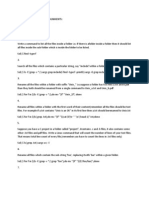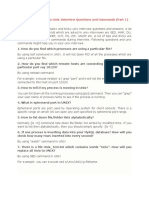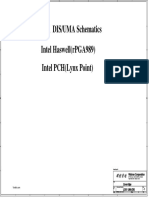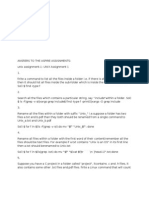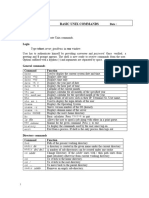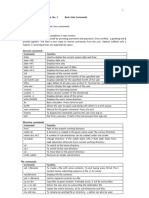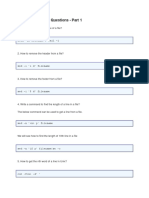Unix Assignment 02
Uploaded by
Prashant UpadhyeUnix Assignment 02
Uploaded by
Prashant UpadhyeUnix assignment 02 CT 20110344102 1.
Create a tree structure named training in which there are 3 subdirectories level 1, level2 and cep. Each one is again further divided into 3. The level 1 is divided into sdp, re and se. From the subdirectory se how can one reach the home directory in one step and also how to navigate to the subdirectory sdp in one step? Give the commands, which do the above actions? Ans) $ mkdir training $ cd training $ mkdir level1 level2 cep $ cd level1 $ mkdir sdp re se $ cd se $ pwd /home/Mani/training/level1/se $ cd ~ $ pwd /home/Mani $cd training $cd level1 $cd se $cd ../sdp $pwd /home/Mani/training/level1/sdp
2. How will you copy a directory structure dir1 to dir2 ? (with all the subdirectories) Ans) $ cp -R dir1 dir2
3. How can you find out if you have the permission to send a message? Ans) $ ls -l
4. Find the space occupied ( in Bytes) by the /home directory including all its subdirectories. Ans) $ du -sb
5. What is the command for printing the current time in 24-hour format? Ans) $ date +%T
6. What is the command for printing the year, month, and date with a horizontal tab between the fields? Ans) $ date +%Y%t%m%t%d
7. Create the following files: chapa, chapb, chapc, chapd, chape, chapA, chapB, chapC, chapD, chapE, chap01, chap02, chap03, chap04, chap05, chap11, chap12, chap13, chap14, and chap15. Ans) $ touch chapa chapb chapc chapd chape chapA chapB chapC chapD chapE chap01 chap02 chap03 chap04 chap05 chap11 chap12 chap13 chap14
8. With reference to question 7, What is the command for listing all files ending in small letters?
Ans) $ find . -name *[a-z]
9. With reference to question 7, What is the command for listing all files ending in capitals? Ans) $ find . -name *[A-Z]
10. With reference to question 7, What is the command for listing all files whose last but one character is 0? Ans) $ find . name *0?
11. With reference to question 7, What is the command for listing all files which end in small letters but not a and c? Ans) $ find . -name *[bd-z]
12. In an organisation one wants to know how many programmers are there. The employee data is stored in a file called personnel with one record per employee. Every record has field for designation. How can grep be used for this purpose? Ans) $ grep -c programmer personnel
13. In the organisation mentioned in question 12 how can sed be used to print only the records of all employees who are programmers. Ans) $ sed -n "/programmer/p" personnel
14. In the organisation mentioned in question 12 how can sed be used to change the designation programmer to software professional every where in the personnel file Ans) $ sed -e "s/programmer/software professional/g" personnel
15. Find out about the sleep command and start five jobs in the background, each one sleeping for 10 minutes. Ans) $ sleep 10 & sleep 10 & sleep 10 & sleep 10 & sleep 10 &
16. How do you get the status of all the processes running on the system? i.e. using what option?
Ans) $ ps -e
You might also like
- 35 Tricky and Complex Unix Interview Questions and CommandsNo ratings yet35 Tricky and Complex Unix Interview Questions and Commands8 pages
- PCEquipmentLib 1.3-0 Engineering Guidelines 3BEL300674D8007 Rev A PDFNo ratings yetPCEquipmentLib 1.3-0 Engineering Guidelines 3BEL300674D8007 Rev A PDF177 pages
- Lenovo ThinkPad L440 Wistron LOS 1 DIS UMA 12289 1 Rev 1No ratings yetLenovo ThinkPad L440 Wistron LOS 1 DIS UMA 12289 1 Rev 1102 pages
- Plano de Teste DB 2435-5686 John Deere 5425100% (1)Plano de Teste DB 2435-5686 John Deere 54254 pages
- Raish Vhora: K.P.Patel School of Management & Computer Studies (KSMCS)No ratings yetRaish Vhora: K.P.Patel School of Management & Computer Studies (KSMCS)32 pages
- Pcas6 - Java Programming: Practical RecordsNo ratings yetPcas6 - Java Programming: Practical Records15 pages
- Write A Shell Program To Read A Number and Reverse The NumberNo ratings yetWrite A Shell Program To Read A Number and Reverse The Number5 pages
- Lab Instructions: A. How To Login To Emerald ClusterNo ratings yetLab Instructions: A. How To Login To Emerald Cluster7 pages
- Kuvempu University: Laboratory Assignments Subject: UNIX & Shell Programming Subject Code: BSIT - 43No ratings yetKuvempu University: Laboratory Assignments Subject: UNIX & Shell Programming Subject Code: BSIT - 435 pages
- Linux Job Interview Questions: Building A Separate Partition For Squid Cache Autoblock Ips With Failed SSH LoginsNo ratings yetLinux Job Interview Questions: Building A Separate Partition For Squid Cache Autoblock Ips With Failed SSH Logins12 pages
- M.A.M. School of Engineering: Siruganur, Trichy - 621 105No ratings yetM.A.M. School of Engineering: Siruganur, Trichy - 621 10578 pages
- Advanced Linux: Exercises: 0 Download and Unpack The Exercise Files (Do That First Time Only)No ratings yetAdvanced Linux: Exercises: 0 Download and Unpack The Exercise Files (Do That First Time Only)6 pages
- LAB MANUAL - OS - 2021 Regulation Final-1No ratings yetLAB MANUAL - OS - 2021 Regulation Final-168 pages
- Unix Essentials Featuring The Solaris 10 Operating System-MyExercisesNo ratings yetUnix Essentials Featuring The Solaris 10 Operating System-MyExercises37 pages
- Hadoop Fundamentals and Hive Interview QuestionsNo ratings yetHadoop Fundamentals and Hive Interview Questions8 pages
- UNIX Shell Programming Interview Questions You'll Most Likely Be AskedFrom EverandUNIX Shell Programming Interview Questions You'll Most Likely Be AskedNo ratings yet
- Machine Learning: Hands-On for Developers and Technical ProfessionalsFrom EverandMachine Learning: Hands-On for Developers and Technical ProfessionalsNo ratings yet
- Linux System Administrator Interview Questions You'll Most Likely Be AskedFrom EverandLinux System Administrator Interview Questions You'll Most Likely Be AskedNo ratings yet
- MCC7500 Operator Workshop: Course IntroductionNo ratings yetMCC7500 Operator Workshop: Course Introduction6 pages
- File: /home/nagp/cracker - List - TXT Page 1 of 1No ratings yetFile: /home/nagp/cracker - List - TXT Page 1 of 11 page
- Module 4 Sheet 2.3 Software Packages and Use of Application ProgramsNo ratings yetModule 4 Sheet 2.3 Software Packages and Use of Application Programs22 pages

